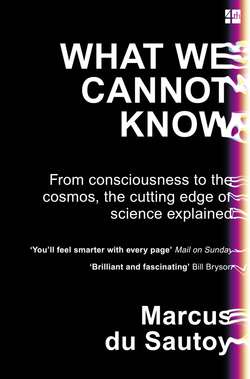Читать книгу What We Cannot Know: Explorations at the Edge of Knowledge - Marcus Sautoy du - Страница 20
Calculus: making sense of zero divided by zero
ОглавлениеSuppose that a car starts from a stationary position. When the stopwatch starts, the driver slams his foot on the accelerator. Suppose that we record that after t seconds the driver has covered t × t metres. How fast is the car going after 10 seconds? We get an approximation of the speed by looking at how far the car has travelled in the period from 10 to 11 seconds. The average speed during this second is (11 × 11 – 10 × 10)/1 = 21 metres per second.
But if we look at a smaller window of time, say the average speed over 0.5 seconds, we get:
(10.5 × 10.5 – 10 × 10)/0.5 = 20.5 metres per second.
Slightly slower, of course, because the car is accelerating, so on average it is going faster in the second half second from 10 seconds to 11 seconds. But now we take an even smaller snapshot. What about halving the window of time again:
(10.25 × 10.25 – 10 × 10)/0.25 = 20.25 metres per second.
Hopefully the mathematician in you has spotted the pattern. If I take a window of time which is x seconds, the average speed over this time will be 20 + x metres per second. The speed as I take smaller and smaller windows of time is getting closer and closer to 20 metres per second. So, although to calculate the speed at 10 seconds looks like I have to figure out the calculation 0⁄0, the calculus makes sense of what this should mean.
Newton’s calculus made sense of this calculation. He understood how to calculate what the speed was tending towards as I make the time interval smaller and smaller. It was a revolutionary new language that managed to capture a changing dynamic world. The geometry of the ancient Greeks was perfect for a static, frozen picture of the world. Newton’s mathematical breakthrough was the language that could describe a moving world. Mathematics had gone from describing a still life to capturing a moving image. It was the scientific equivalent of how the dynamic art of the Baroque burst forth during this period from the static art of the Renaissance.
Newton looked back at this time as one of the most productive of his life, calling it his annus mirabilis. ‘I was in the prime of my age for invention and minded Mathematicks and Philosophy more than at any time since.’
Everything around us is in a state of flux, so it was no wonder that this mathematics would be so influential. But for Newton the calculus was a personal tool that helped him reach the scientific conclusions that he documents in the Principia, the great treatise published in 1687 that describes his ideas on gravity and the laws of motion.
Writing in the third person, he explains that his calculus was key to the scientific discoveries contained inside: ‘By the help of this new Analysis Mr Newton found out most of the propositions in the Principia.’ But no account of the ‘new analysis’ is published. Instead, he privately circulated the ideas among friends, but they were not ideas that he felt any urge to publish for others to appreciate.
Fortunately this language is now widely available and it is one that I spent years learning as a mathematical apprentice. But in order to attempt to know my dice I am going to need to mix Newton’s mathematical breakthrough with his great contribution to physics: the famous laws of motion with which he opens his Principia.
